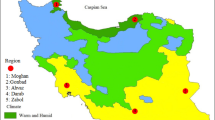Abstract
The suitability of regression analysis for studying the phenotypic stability of grain yield was investigated using a collection of 220 Nordic barley lines. Linear regression explained 26–52% of the genotype x environment (GE) interactions in different groupings of the material. The regression coefficient, b i , measures the yield response of the i-th genotype to improved environmental conditions. Deviations from regression, S 2 di , have been used to estimate Tai's stability parameter, λ i , which is a measure of the phenotypic yield stability in the agronomic sense. Repeatability of b i , λ i , and grain yield was studied by means of correlations between estimates obtained in each experimental year. Yield had the highest repeatability, with correlations between years ranging from 0.57 to 0.85. In this study, regression coefficients and λ i -values were not repeatable, i.e. genotypes reacted differentially to the yearly climatic variations. Six-rowed (6r) barleys had higher responsiveness, but lower mean yields, than two-rowed (2r) barleys. This is partly due to the history of selection of 6r-barleys, which mainly originate from regions with low potential yield levels, i.e. Finland and Norway. In general, responsiveness and stability were not correlated with yield. The highest-yielding lines had b i ≈1. The response pattern of the different types of barleys used in this study show that responsiveness can be changed by recombination.
Similar content being viewed by others
References
Aastveit AH (1977) Statistical analyses of field trials with a large number of entries. Thesis, Mathematical Statistics, University of Oslo (in Norwegian)
Allard RW, Bradshaw AD (1964) Implications of genotype-environmental interactions in applied plant breeding. Crop Sci 4:503–508
Allen FL, Comstock RE, Rasmusson DC (1978) Optimal environments for yield testing. Crop Sci 18:747–751
Austin RB (1988) A different ideotype for each environment? In Jorna ML, Slootmaker LAJ (eds) Cereal breeding related to integrated cereal production. EUCARPIA Proc Conf Cereal Section, Pudoc, Wageningen, pp 47–60
Becker HC (1981) Biometrical and empirical relations between different concepts of phenotypic stability. In: Gallais A (ed) Quantitative genetics and breeding methods. EUCARPIA Proc 4th Meet Section Biometrics Plant Breeding, 2–4 September 1981, Poitiers, France. INRA, Versailles, pp 307–314
Becker HC (1983) Züchterische Möglichkeiten zur Verbesserung der Ertragssicherheit. Vortr Pflanzenzüchtg 3:203–225
Becker HC (1984) Analysis of genotype x environment interactions with partitioning of environmental effects into effects of locations and years. Vortr Pflanzenzüchtg 7:209–218
Becker HC, Léon J (1988) Stability analysis in plant breeding. Plant Breed 101:1–23
Ceccarelli S, Grando S (1991) Selection environment and environmental sensitivity in barley. Euphytica 57:157–167
Eberhart SA, Russell WA (1966) Stability parameters for comparing varieties. Crop Sci 6:36–40
Finlay KW, Wilkinson GN (1963) The analysis of adaptation in a plant-breeding programme. Aust J Agric Res 14:742–754
Jalaluddin Md, Harrison SA (1993) Repeatability of stability estimators for grain yield in wheat. Crop Sci 33:720–724
Knight R (1970) The measurement and interpretation of genotypeenvironment interactions. Euphytica 19:225–235
Langer I, Frey KJ, Bailey T (1979) Associations among productivity, production response, and stability indexes in oat varieties. Euphytica 28:17–24
Léon J, Becker HC (1988) Repeatability of some statistical measures of phenotypic stability — correlations between single-year results and multi-year results. Plant Breed 100:137–142
Lin CS, Binns MR (1988) A method of analyzing cultivar x location x year experiments: a new stability parameter. Theor Appl Genet 76:425–430
Lin CS, Binns MR (1991) Assessment of a method of cultivar selection based on regional trial data. Theor Appl Genet 82:379–388
Nilsen J (1983) Light climate in northern areas. In Kaurin Å, Junttila O, Nilsen J (eds) Plant production in the north. Norwegian University Press, pp 62–72
Nissilä E (1992) Yield stability parameters of barley under Finnish conditions. Acta Agric Scand, Sect B, Soil and Plant Sci 42:152–157
Nurminiemi M, Bjørnstad Å, Rognli OA (1996) Yield stability and adaptation of Nordic barleys. Euphytica (in press)
Perkins JM, Jinks JL (1968a) Environmental and genotype-environmental components of variability.III. Multiple lines and crosses. Heredity 23:339–356
Perkins JM, Jinks JL (1968b) Environmental and genotype-environmental components of variability. IV. Non-linear interactions for multiple inbred lines. Heredity 23:525–535
Pfeiffer WH, Braun HJ (1989) Yield stability in bread wheat. In: Anderson JR, Hazell PBR (eds) Variability of grain yields. Implications for agricultural research and policy in developing countries. John Hopkins, University Press, Baltimore, pp 157–174
Pham HN, Kang MS (1988) Interrelationships among and repeatability of several stability statistics estimated from international maize trials. Crop Sci 28:925–928
Reysack JJ, Stuthman DD, Stucker RE (1993) Recurrent selection in oat: stability of yield and changes in unselected traits. Crop Sci 33:919–924
Shabana R, Bailey T, Frey KJ (1980) Production traits of oats selected under low, medium, and high productivity. Crop Sci 20:739–744
Simmonds NW (1991) Selection for local adaptation in a plant breeding programme. Theor Appl Genet 82:363–367
Skrøppa T (1984) A critical evaluation of methods available to estimate the genotype x environment interaction. Studia For Suec 166:3–14
SNP (1986) Samordnad odlingsvärdesprovning i Norden. SNP publikation nr. 14. Nordisk Ministerråd, Oslo, Norway SNP (1992) Agroklimatisk kartlegging av Norden. Samnordisk planteforedling. Skrifter och rapporter nr 5. BTJ Tryck AB, Lund, Sweden
Tai GCC (1971) Genotypic stability analysis and its application to potato regional trials. Crop Sci 11:184–190
Wiberg A (1993) Norrländskt jordbruk — finns det behov av speciell sortframställning? Sveriges Utsädesf Tidskr 103:17–24
Yates F, Cochran, WG (1938) The analysis of groups of experiments. J Agric Sci 28:556–580
Yue G, Perng SK, Walter TL, Wassom CE, Liang GH (1990) Stability analysis of yield in maize, wheat and sorghum and its implications in breeding programs. Plant Breed 104:72–80
Author information
Authors and Affiliations
Additional information
Communicated by P. M. A. Tigerstedt
Rights and permissions
About this article
Cite this article
Nurminiemi, M., Rognli, O.A. Regression analysis of yield stability is strongly affected by companion test varieties and locations — examples from a study of Nordic barley lines. Theoret. Appl. Genetics 93, 468–476 (1996). https://doi.org/10.1007/BF00223192
Received:
Accepted:
Issue Date:
DOI: https://doi.org/10.1007/BF00223192




